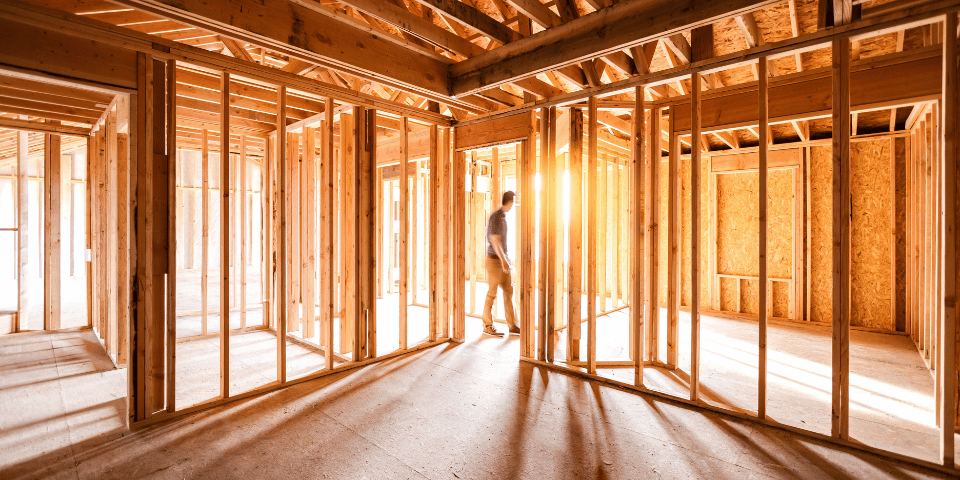A Complete Guide to Home Construction Loans
May 23, 2024

Whether you're building your dream house with room to grow a family or downsizing for an empty nest, building a home is an experience many of us dream about.
From perusing house plans to selecting flooring and fixtures, the decisions can seem endless and overwhelming. So, before you find yourself lost in the latest issue of Architectural Digest, there are a few things you need to know about construction loans before diving in headfirst.How Do Construction Loans Work?
Unlike a traditional mortgage loan, which is used to purchase an existing move-in-ready home, construction loans are specifically designed to finance the construction of a new home from land purchase through finished construction.
Construction loans are typically short in term - typically 12 months - and cover the following expenses during the construction of a residential home:
- Land
- Building Permits
- Contractors or Labor Expenses
- Building Supplies
Other criteria that set construction loans apart from traditional mortgages are rates, down payments and loan requirements. Below, we discuss these points in detail.
- Rates - Construction loans tend to have higher loan rates than traditional mortgages. With a traditional home loan, the existing structure serves as collateral. In the case of a construction loan, the only collateral is the land and the unbuilt structure, so the lender assumes more of the risk if the borrower defaults on payments. This is because it is harder for a lender to unload a partially built home - especially a custom one.
- Down Payment - For the same reason that rates tend to be higher on construction loans, down-payment requirements tend to be a bit stricter, with most private lenders requiring anywhere from 5-20% of the loan amount. With a traditional home loan, downpayment typically runs between 3-5% on a conventional loan.
- Draws - Draws refer to the funds that you or the builder “draw down” from the original loan amount. Draws are used to cover the different phases of construction costs. For example, a first draw may include the cost of dirt work to prep the building site and foundation work, as well as the costs of permits, supplies and labor related to that phase.
- Inspector/Appraisal Involvement - With construction loans, lenders require assurance that the draws correspond with the work performed. This is where inspections come in. Typically, four to six times during a twelve-month residential construction project, an inspector will visit the building site to ensure that things are going according to plan. Inspectors typically check to see if the correct permits have been obtained with the city or municipality, that licensed contractors are performing the work and that the draws are in line with the project's progress. This means there is little flexibility for DIY work as part of a cost-saving plan. Lenders want assurance the work is done by professionals and is 100% up to code.
- Interest-Only Payments - Whereas traditional mortgage payments include principal and interest, monthly payments during a construction loan will vary because you only pay interest on the funds drawn down or dispersed. This means that you can generally expect payments to be lower at the start of a project than at the end of the loan term, as most funds will have been expended.
Types of Construction Loans
Options are great, but it’s important to understand all the intricacies. Banks and credit unions offer two main types of traditional construction loans: Interim Construction Loans and Construction-to-Permanent loans. Both start with loan application and approval but vary based on the permanent financing of the loan. Below is an overview of the two types of loans to help you identify the one best for your specific needs.
Interim Construction Loans
An interim construction loan is sometimes called a Construction-Only loan. It is short-term in nature and used to finance the construction of a new home. This type of loan provides funds to cover the cost of the land and construction, including materials, labor, permits, and other expenses associated with homebuilding. Because this type of home loan is interim in nature, it requires you to apply and get approved for a separate mortgage loan that will be used to pay off the construction loan at the end of the project, which could mean additional closing costs. Additionally, not all lenders who offer construction loans also offer permanent mortgages. In this scenario, you'll need to research additional lenders who will also require a thorough review of your finances and the project.
Construction-to-Permanent Loans:
Construction-to-Permanent home loans are often called C-to-P loans or Single-Close construction loans. This convenient financing solution marries the benefits of both construction and permanent mortgages into a single, streamlined package. Unlike traditional construction loans that require the building loan to transition to a permanent mortgage, a C-to-P loan simplifies the process by financing the land, construction and final mortgage simultaneously, allowing for a fluid and hassle-free shift from construction to long-term financing. Like other construction loans, payments are limited to the interest on the disbursed funds throughout the construction phase rather than the entirety of the loan's value, which helps to keep your payments lower while you are waiting to take occupancy of your home.
The benefit of a Construction-to-Permanent home loan is that it converts automatically to a permanent mortgage without needing a separate closing. This transition is often done without additional fees or paperwork, simplifying the process for the borrower and often saving money on additional closing costs. An added benefit is that Single-Close loans sometimes offer rate lock options, which allow you to lock in a favorable interest rate for the permanent mortgage at the beginning of the project, potentially protecting you from rate increases that could occur during the building process.
Alternate Financing
Construction loans are not limited to borrowers with the funds for the higher down payment. The Federal Housing Authority (FHA), Veterans Affairs (VA) and U.S. Department of Agriculture (USDA) also offer construction loans, each with its own set of specific requirements. Here, we'll touch on these three alternate types of construction loans and provide helpful links for you to research additional information.
The Federal Housing Administration backs FHA construction loans and have different requirements from other types of home loans. It’s often easier to qualify for an FHA loan as the down-payment requirements are lower and the debt-to-income ratio (DTI) is more lenient, but borrowers must work with an FHA-approved lender.
VA construction loans cater to active-duty service members, veterans, and qualifying surviving spouses. These loans typically stand out for their flexibility, often waiving the need for a down payment or mortgage insurance. Compared to conventional loans, VA construction loans boast more lenient credit criteria. To secure this financing, applicants must work with a VA-approved lender and builder, and the project may be subject to department inspections.
USDA loans are available exclusively to rural homebuyers with low or moderate incomes. Income limits are region-specific and adhere to stringent guidelines. While USDA loans offer the advantage of no downpayment, applicants must meet a minimum credit score threshold of 640 and cover an upfront 1% guarantee fee.
The Phases of a Construction Loan
Construction loans are unique in that they are dispersed in phases, reflecting the progressive nature of home construction. Here's a breakdown of the typical phases you'll encounter if you build a home from the ground up.
- Pre-Approval and Documentation: Before breaking ground, you must secure pre-approval for a construction loan. This involves submitting detailed documentation, including building plans, cost estimates, and your financial information.
- Closing and Disbursement: Once your loan is approved, you'll proceed to the closing stage, where the loan terms are finalized. After closing, your lender will disburse the funds in predetermined increments - known as draws - as construction progresses.
- Construction Phase: With funds in hand, construction can commence according to the agreed-upon timeline and specifications. During construction, periodic inspections may be conducted to ensure the work meets quality standards.
- Conversion to Permanent Mortgage: Upon completion of construction, the construction loan is either converted into a permanent mortgage or paid off by a new mortgage loan. This process may involve additional paperwork and potentially a new appraisal of the property to ascertain the property's current value post-construction before your lender can finalize your permanent mortgage.
What To Know Before You Borrow
Building a new home is an exciting journey for any homeowner. However, it is essential to conduct thorough research and carefully consider the following factors to determine if this path is right for you.
- Budget and Costs: Determine your budget for construction and ensure that it aligns with your finances. When budgeting to build a home, you need to factor in construction costs and contingencies for unexpected expenses. When the world unexpectedly went on lockdown in 2020 due to COVID-19, no one expected the scarcity and cost of materials to rise as much as they did. The home-building industry was not without exception. The Associated Builders and Contractors reported that "building material costs have increased 37.7% since 2020. Since 2022, lumber has come down 12.3%, but concrete products have increased by 14.8%."
- Builder Selection: You'll want to choose a reputable, experienced builder who can deliver quality craftsmanship within the agreed-upon timeline and budget. As part of the vetting process, you'll want to be certain to verify their credentials, check references, and inquire about past projects to ensure compatibility. It's also important to know that some lenders will only work with a certain subset of “approved” or “pre-approved” builders, so be sure to include this in your research when exploring lenders.
- Loan Terms and Rates: Understand the terms and conditions of the loan, including interest rates, repayment terms, and any associated fees. Different home loans offer different terms, affecting whether you can convert your construction loan to permanent financing or have to apply for a separate loan.
- Contingency Plans: Prepare for unforeseen circumstances during construction, such as delays due to weather, material shortages, or contractor issues. Be sure to ask your lender about extending the loan terms should you encounter any of these hurdles and whether that changes the rate, repayment schedule, etc. You should also have a contingency plan to mitigate potential disruptions in housing if you are leasing an apartment or rental home while building.
Navigating the complexities of financing a construction loan can present significant challenges, often leaving many prospective homeowners feeling overwhelmed and uncertain about the best path forward. Recognizing these hurdles, our team is fully committed to demystifying the process for you, ensuring that you're informed and confident in your financial decisions for building your dream home.
To further empower you in the decision-making process, we've developed an extensive array of online resources designed to simplify complex financial concepts. Our free online mortgage calculators are a perfect starting point, allowing you to estimate monthly payments. For those keeping a close eye on market trends, our rate watch feature offers valuable insights into how fluctuating rates could affect your loan. We also offer personalized rate quotes because every homeowner's situation is unique. Considering your specific financial profile and project details, we can provide a more accurate estimate of the rates you might expect, helping you plan more effectively for your future.
And for those who value a more hands-on approach, we invite you to book an appointment with one of our expert mortgage loan officers. Whether you're in the early stages of considering a construction loan or ready to take the next steps, we're here to make the process as smooth and straightforward as possible. At Education First FCU, we understand that building a home is more than just a financial transaction—it's a deeply personal journey toward creating a space where your life will unfold. Join us, and let's embark on this exciting journey together.


.png?width=352&name=FirstTime%20Homebuyer%20Mistakes_%20960_480%20(8).png)
.png?width=352&name=Buying%20a%20Home%20in%20a%20Changing%20Market%20(960%20%C3%97%20480%20px).png)
